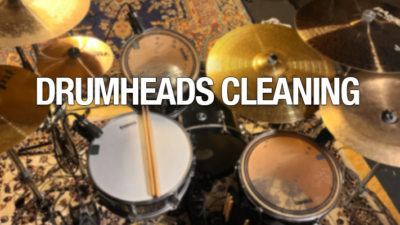When to replace drum heads is one of the most common questions drummers ask, and to be honest – it’s one of the most overlooked issues that kills your tone.
If your drums are sounding dull, refusing to stay in tune or feel dead under the stick, your heads might be way past their prime. I’ve pushed mine too far before (thinking I was saving money) and got to the point when, during a gig, I broke my snare – not the ideal scenario if you ask me.
Replace drum heads when you notice dead tone, visible damage like dents or pits, or tuning issues that don’t improve.
Drumheads usually wear out in 6-9 months. Snare and tom heads wear out fastest, while kick and resonant heads last longer.
In this article, we’ll walk through the 3 most important signs it’s time to change your drumheads. Also, will give you some tips to help you get the most life and tone out of each head.
Sign #1: Dead Tone
This is usually the first and loudest sign (ironically) that your drumheads are done.

Dead drumhead sound isn’t just about volume – it’s about the tone. If your snare or toms used to sing but now sound dull, thuddy, or lifeless, your heads have likely worn out. Especially if tuning them doesn’t seem to bring that snap or resonance back.
I remember doing a session where my floor tom sounded like I was hitting wet cardboard. I thought it was mic placement. Nope. The head was just done – no more sustain, no ring, just flat. Swapped it out for a fresh Remo Emperor and boom – depth, clarity, and punch came back immediately.

What does a dead drum head sound like?
- Muffled or dull tone with zero resonance
- No sustain, even when tuned high
- Unbalanced overtones, often shifting mid-song
- Flat feel under the stick – no bounce or rebound
Drummers often ask, “how long do drumheads last?” And truth is, it varies depending on how hard you play, what genre you’re in, and how often you’re behind the kit. But the moment your tone starts dying? That’s your cue.
Bonus tip: Always trust your ears. If something sounds off and tuning doesn’t help, your heads may be the problem – not your shells or your playing.
Sign #2: Visible Damage
Sometimes it’s not about what you hear – it’s what you see.
If your drumhead is full of dents, pits, or warped areas, it’s time to toss it. Even small indentations can mess with your tone, rebound, and tuning. The most common damage happens on snare drumheads (especially from rimshots) and toms that take a beating in live settings.

Want to learn how to choose the right head from the start?
Check out our in-depth guide: How to Choose the Best Drumheads Like a Pro
I once went on a small tour with a dented snare head thinking, “It’s fine, still sounds decent…” By the second gig, that thing wouldn’t tune at all. The damage was uneven, which threw off the entire head tension, and I ended up switching to my backup mid-set.
Signs of physical wear:
- Dents or dimples where the stick hits most
- Splits or cracks in the film (check for hairline damage under bright light)
- Coating worn off (especially on coated snare heads)
- Deformation around the edge or seating area
Pro Tip: Coated heads tend to wear visually faster, but even clear heads will lose elasticity and integrity over time. Especially single ply heads like Remo Ambassador or Evans G1.
Want to understand how ply construction affects head life? Read our Single Ply vs Double Ply Drumheads Explained article to see why 2-ply heads are built to last longer under stress.
Sign #3. Tuning Issues
When you can’t get your drum to tune evenly, or it goes out of tune mid-song, your head is probably past its lifespan.
Yes, sometimes it’s user error (we’ve all overtightened a lug or missed a tension spot), but if you’ve tried reseating the head, tuning evenly, even changing your snare wires or reso head – and it still won’t hold pitch? The batter head’s likely stretched or warped.

Need to upgrade? We also hand-tested dozens of popular picks in our gear roundup: Best Drumheads in 2025 for Every Genre, Budget & Skill Level
I had an Aquarian Super-Kick II on my bass drum that sounded great for months. But once it hit that wear point, it kept flopping around the pitch range no matter how I tuned it.
Replaced it with a fresh EMAD and instantly got that solid thump and tuning stability back.
Warning signs:
- Uneven tension even with perfect lug tuning
- Pitch changes during songs
- Buzzes or warble from warped head film
- Lugs feel too tight, but the drum still sounds flat
This issue especially creeps up on snare drums and floor toms, since those heads take the most abuse and need consistent tuning.
Final Thoughts: When Should You Replace Drum Heads?
So, when to replace drum heads really comes down to three simple things:
- Your tone goes flat or lifeless
- You see dents, pits, or coating wear
- You can’t tune your drums no matter what
If any of those sound familiar? You’re due. And trust me, putting on a fresh set is one of the fastest ways to fall back in love with your kit. I’ve had sessions where just swapping a snare head made the whole mix sit better, no EQ needed.
If you are not sure which heads to get next, we’ve got you covered with these two must-read resources:
- How to Choose Drumheads Like a Pro – Learn about ply, coating, head types, and what fits your playing style.
- Best Drumheads in 2025 for Every Genre – Our hand-tested picks for rock, jazz, metal, and more.
Heads don’t last forever. But if you know the signs, you can catch the problems early, save your gigs, and get way better sound from your drums – every time you play.



